Betta Fish Eggs The Miracle of Birth
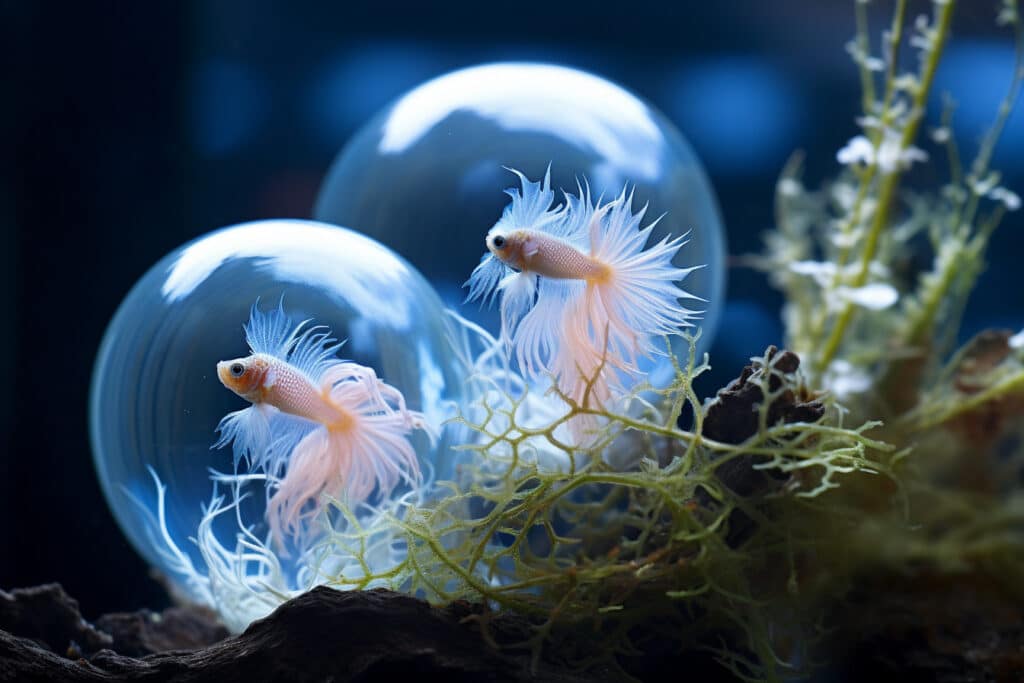
Welcome to our blog post about Betta Fish Eggs.
As you might already know, Betta fish breeding is a captivating and rewarding aspect of fishkeeping that has fascinated hobbyists for generations.
These vibrant and mesmerizing creatures display unique courtship rituals and behaviors during their breeding process. As a fish enthusiast, delving into the world of betta fish breeding allows you to witness the wonders of nature unfold right in your own aquarium.
One of the most crucial stages in the breeding journey is the formation and development of betta fish eggs. Understanding this vital aspect is essential for successful breeding and ensuring the well-being of both the parent bettas and their offspring.
Table of Contents
Betta Fish Eggs and Breeding Behavior In Nature
Betta fish are known for their intriguing courtship rituals. In the wild, male bettas build bubble nests to impress potential mates. They perform a captivating “love dance” where they flare their fins and display vibrant colors to attract females.
Understanding these innate behaviors can help recreate a suitable environment for successful breeding in captivity.
How to Identify a Spawning Bettas
Selecting a compatible mating pair is essential for successful breeding. Look for healthy, active, and fully matured bettas to increase the chances of a successful spawn. Observing their behaviors and ensuring they display interest in each other can help identify a promising spawning pair.
Male Betta Fish
When a male betta is ready to pair and initiate the breeding process, he will exhibit several signs of readiness. Here are some common signs that indicate a male betta is prepared for mating:
Bubble Nest Building
One of the clearest signs of a male betta’s readiness to pair is his active construction of a bubble nest. He will create a cluster of bubbles at the water’s surface using saliva and bubbles he blows. This nest serves as a place for the eggs to be laid and protected during the spawning process.
Bright Coloration and Display
A male betta in breeding condition will display vibrant and intense colors, particularly on his fins and body. He will also flare his fins and gill covers as part of his courtship display to attract the female’s attention.
Vertical Bars or “Breeding Stripes”
When a male betta is excited and ready to pair, he may display vertical bars, often referred to as “breeding stripes,” on his body. These bars are more pronounced and visible under certain lighting conditions and indicate his readiness for mating.
Active Swimming Near the Bubble Nest
The male betta will be actively swimming around the bubble nest he created, guarding and maintaining it in anticipation of the female’s arrival.
Flaring Behavior
He may flare his fins and gill covers when interacting with the female or when he feels threatened by other males in nearby tanks.
Building a Mound or Tunnel
In some cases, instead of a bubble nest, the male may construct a mound or a tunnel using substrate or other tank materials as an alternative site for the eggs.
It’s important to note that while these signs indicate the male’s readiness to breed, successful breeding also depends on the female’s willingness to pair and spawn. Observing both the male and female’s behavior and compatibility is essential for a successful breeding process.
Female Betta Fish
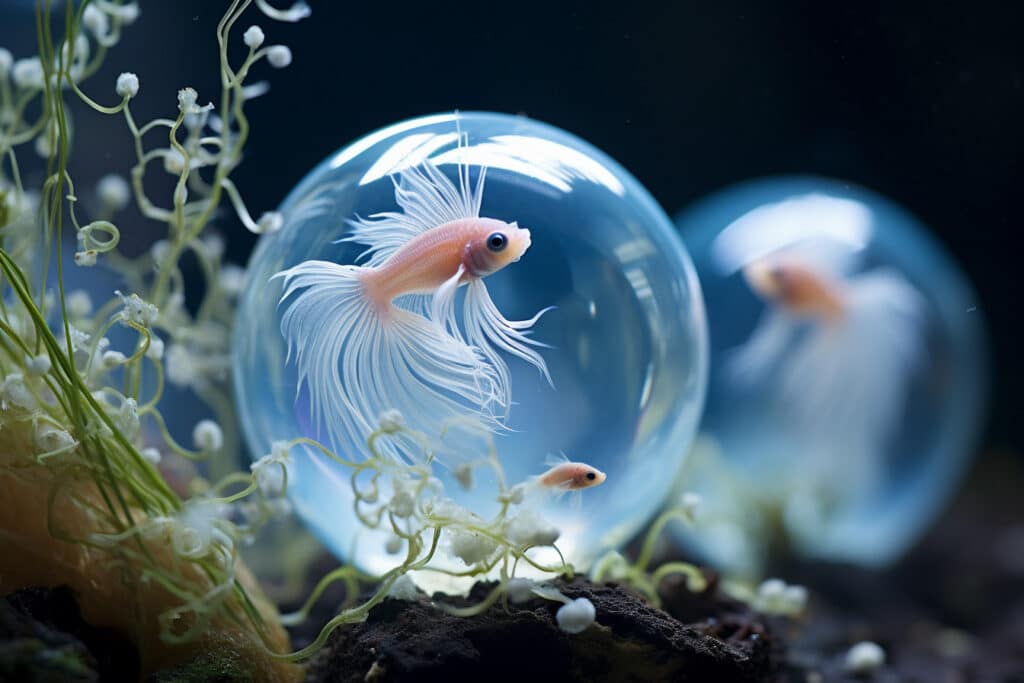
When a female betta is ready to pair and engage in the breeding process, she will exhibit specific behaviors and physical changes. Here are some signs that indicate a female betta is prepared for mating:
Vertical Bars or Breeding Stripes
Like male bettas, female bettas also display vertical bars or “breeding stripes” on their bodies when they are ready to pair. These bars are more visible and pronounced under certain lighting conditions and signify their readiness for mating.
Swelling and Rounded Belly
A female betta ready to spawn will have a swollen and rounded belly, indicating that she is carrying eggs. The presence of eggs causes her abdomen to become visibly larger.
Horizontal Posture
When a female betta is in breeding condition, she may assume a horizontal or slightly angled position in the water, as opposed to the more upright posture she usually maintains.
Curious and Active Behavior
A female betta ready to pair may become more active and curious, exploring her environment and swimming near the male’s bubble nest or alternative spawning site.
Approaching the Male
In response to the male’s courtship display, a receptive female will swim closer to the male, sometimes showing submissive behaviors like lowering her body or extending her fins.
Egg Spot Darkening
Some female bettas have an “egg spot” near their ventral fins, which resembles a small white dot. When she is ready to spawn, this egg spot may darken, becoming more noticeable.
Flashing
Female bettas might display “flashing” behavior, where they rub their bodies against tank surfaces or objects. This behavior is a sign of excitement and receptiveness.
It’s essential to monitor both the male and female bettas’ behaviors closely to ensure they are compatible and willing to pair. Successful breeding requires both male and female bettas to be in proper breeding conditions and receptive to each other’s signals.
Triggering The Breeding Process
In a well-maintained aquarium, bettas can be prompted to breed through specific environmental changes. Adjusting the water temperature, increasing humidity, and providing appropriate hiding spots can stimulate the breeding process.
Creating a suitable breeding environment is crucial for the successful reproduction of betta fish. Follow these steps to set up the perfect breeding tank:
Select the Right Tank
Choose a separate breeding tank with a capacity of at least 10-20 gallons. A larger tank provides more stability and space for the bettas include also a fish breeding box for the female to let the couple get to know each other and if the male shows any signs of aggression the female will be safe.
Adjust Water Parameters
Maintain the water temperature between 78-80°F (25-27°C) using a reliable aquarium heater. Keep the pH level around 7 and ensure the water is free from harmful substances like chlorine and heavy metals.
Provide Hiding Spots
Add plenty of live plants and Indian almond leaves, caves, or spawning mops to create hiding spots. These spaces allow the female betta to take refuge and reduce the risk of aggression from the male.
Add Substrate
Choose a fine-grained substrate, such as aquarium sand or marbles, which allows the eggs to fall through and prevents them from being eaten.
Install a Filter
Use a gentle sponge or sponge filter to maintain water circulation without creating strong currents that may harm the eggs or fry.
Condition the Breeders
Before introducing the bettas to the breeding tank, condition them with a high-quality diet, including live or frozen foods. This helps to enhance their overall health and reproductive readiness.
By creating the right environment, you’ll give your betta fish the best chance for successful breeding and the growth of healthy fry.
Betta Fish Mating Process
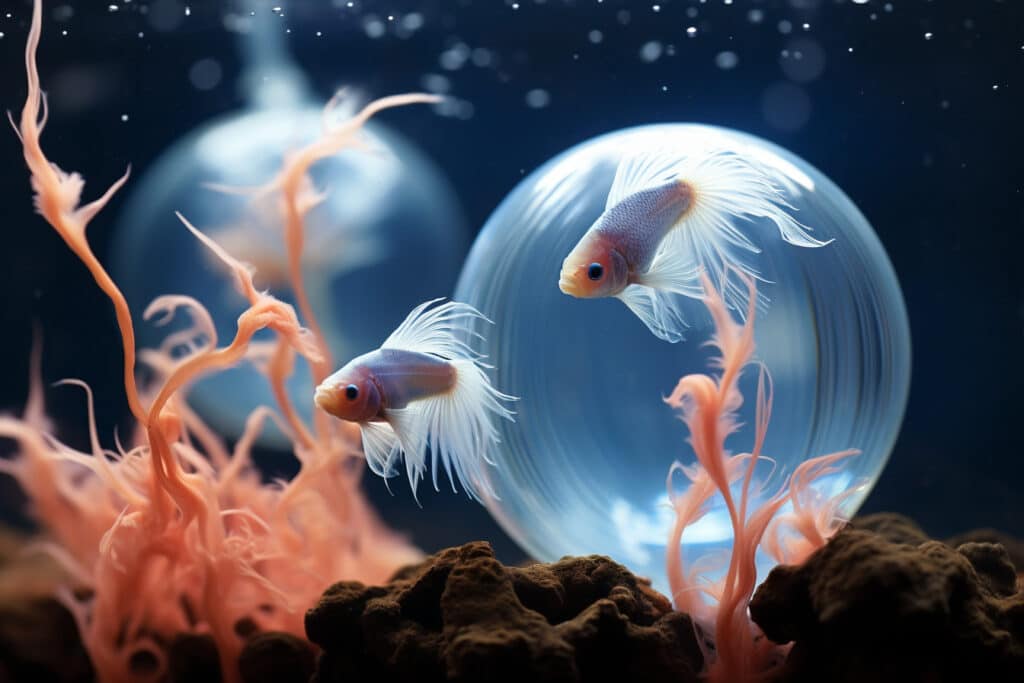
The mating process of Betta fish is a fascinating display of courtship and instinct.
When a male Betta is ready to breed, he begins building a bubble nest at the water’s surface using saliva and bubbles. This nest serves as a safe place for the eggs Once the nest is complete, the male displays his vibrant colors and extends his fins to impress the female.
During courtship, the male may perform a dance-like swim to entice the female. If the female is receptive, she will respond with her own displays of color and behavior. The male then wraps his body around the female, triggering her to release eggs.
After the female betta fish lays eggs, the male quickly gathers them in the bubble nest. The mating process requires patience and preparation, and observing this natural behavior is a captivating experience for fish enthusiasts.
How Many Eggs Does a Betta Fish Lay During Mating?
Female betta fish can produce a wide range of eggs during mating, usually between 100 to 1000 eggs in a single spawning event. The number of eggs can vary based on factors such as the age and size of the female, environmental conditions, and overall health. It’s important to provide proper care and conditions for both the eggs and the fry (baby bettas) after they hatch.
Betta Fish Eggs Hatching Process
The hatching process of Betta fish eggs is a thrilling spectacle to witness. After the female carefully lays her eggs in the bubble nest prepared by the male, the eggs will be tenderly guarded by the father.
Betta Fish Egg Colors and Shapes
Betta fish eggs come in a diverse range of colors and shapes, and each variation provides valuable insights into the breeding process.
Betta fish eggs look like small, spherical, and translucent in appearance, resembling tiny gelatinous pearls. They are typically around 1 to 1.5 millimeters in size, making them barely visible to the naked eye.
The color of the eggs can vary from translucent to opaque, depending on the genetics of the parent fish. While most eggs are spherical in shape, some may appear slightly elongated or irregular. The colors and shapes can also be influenced by environmental factors and the health of the breeding pair.
Observing these unique characteristics can not only be fascinating for fish enthusiasts but can also help breeders identify the health and quality of the eggs.
Properly understanding the colors and shapes of betta fish eggs is an essential skill for successful breeding endeavors and ensuring the well-being of the new betta fry.
How To Know if The Betta Fish Eggs Are Fertilized
Determining whether Betta fish eggs are fertilized can be challenging, especially for inexperienced breeders. However, there are some visual cues you can look for to gauge fertilization:
Transparency: Fertilized eggs tend to become transparent and develop a small, dark spot at the center, known as the embryo, within a day or two after spawning.
Cloudiness: Unfertilized eggs might appear opaque and clouded over time, indicating that they are not developing and will likely turn white and moldy.
Clustering: Fertilized betta eggs typically adhere to the nesting site (such as a bubble nest or plant) in a cluster, while unfertilized eggs may scatter around the tank.
Male’s Behavior: The male Betta plays an essential role in fertilization. If he is actively tending to the eggs and guarding the nest, it is a good sign that the eggs are fertilized.
It’s important to note that successful breeding requires patience and practice. Sometimes, even fertilized eggs may not survive due to various factors. Providing a suitable environment and carefully observing the eggs can increase the chances of successful breeding.
Unfertilized Betta Eggs
Unfertilized Betta fish eggs do not undergo the fertilization process and will not develop into viable fry. Once the female Betta has laid the eggs, the male Betta must fertilize them by releasing his milt over them.
If the eggs are not fertilized within a certain period, usually within 24-48 hours, they will remain unfertilized and will eventually deteriorate and turn fuzzy or moldy. Unfertilized eggs are typically white or opaque and do not show any signs of development.
In a well-monitored breeding environment, it’s essential to remove any unfertilized eggs promptly to prevent them from contaminating the breeding tank and to focus the male Betta’s attention on caring for the fertilized eggs.
Proper egg removal helps maintain the overall health and cleanliness of the breeding tank, ensuring the best chance for the viable eggs to hatch and develop into healthy fry.
Betta Fish Eggs Hatching Time
The time it takes for Betta fish eggs to hatch can vary depending on factors like water temperature and the overall health of the eggs. On average, it usually takes about 24 to 48 hours for the eggs to hatch after being laid by the female Betta. During this period, it’s essential to monitor the eggs closely and ensure a stable and suitable environment to promote successful hatching.
Keep The Eggs In A Separate Tank Or Divider
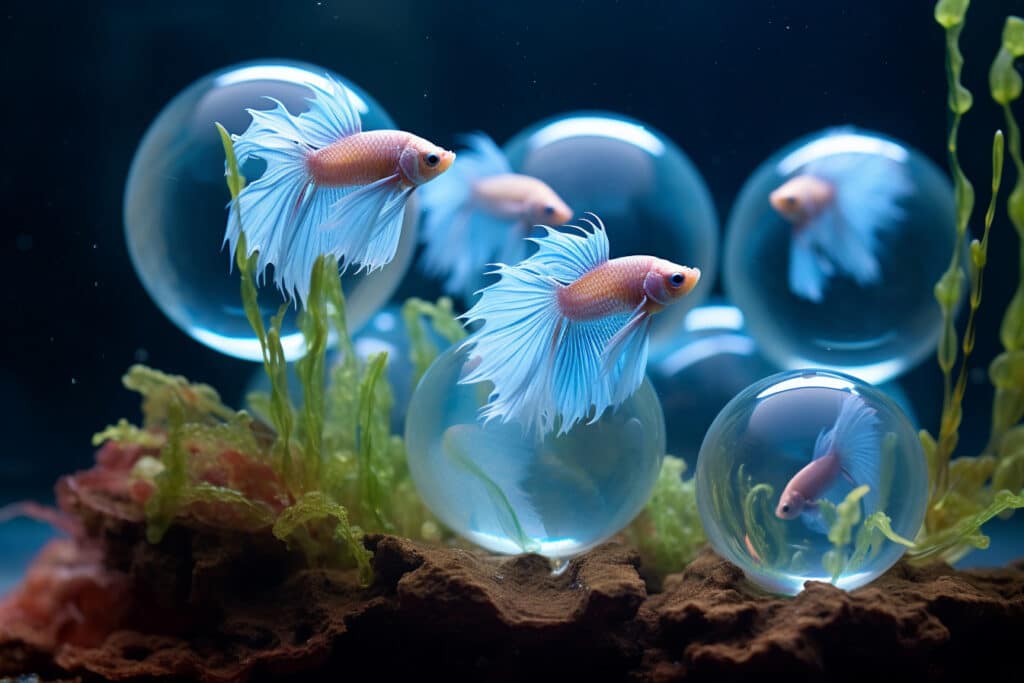
Keeping the Betta fish eggs in a separate tank or using a divider is a crucial step in ensuring the successful hatching and survival of the fry.
After the male Betta has fertilized the eggs and the female is removed from the breeding tank, it’s essential to transfer the eggs to a safe and controlled environment. Placing them in a separate tank or using a divider in the breeding tank prevents the risk of the male consuming the eggs, as some males may display cannibalistic tendencies towards the eggs.
Additionally, a separate tank allows for better water quality management and temperature control, which are vital for the proper development of the eggs. It also reduces stress on the male Betta, allowing him to focus on tending to the eggs without disturbances from other tank mates.
By providing a dedicated space for the eggs, breeders increase the likelihood of successful hatching and create a nurturing environment for the future fry.
Caring For The Betta Frys
Caring for the fry after the betta eggs hatch is a crucial and delicate process. Once the eggs have hatched, the fry will remain attached to the nest by their yolk sacs for a few days. During this time, it’s important to maintain a stable and clean environment in the breeding tank.
Avoid disturbing the fry and ensure the water quality is optimal, with appropriate filtration and regular water changes.
After the fry has become free-swimming, usually within a week, they will need to be fed with infusoria or commercially available liquid fry food.
As they grow, their diet can transition to newly hatched brine shrimp or crushed high-quality flake food. It’s essential to keep the tank environment pristine, provide adequate hiding places, and separate any aggressive fry to prevent injuries.
Regular monitoring, attentive care, and maintaining suitable water conditions will promote the healthy growth and development of the betta fry into robust and colorful adult bettas.
Betta Fry Care Guide
Taking care of the fry after hatching is a crucial and rewarding process. Here’s a step-by-step guide to ensure the best care for your tiny bettas:
Maintain a Stable Environment
Keep the breeding tank clean and stable. Maintain a consistent temperature between 80°F to 82°F (27°C to 28°C) and monitor water parameters like ammonia, nitrite, and nitrate levels regularly.
Protect the Fry
Once the fry becomes free-swimming, ensure there are plenty of hiding places like live plants or fine mesh nets to protect them from adult bettas or potential predators.
Feeding the Fry
Start feeding the fry with infusoria or commercially available liquid fry food within 24 to 48 hours after they become free-swimming. Gradually introduce newly hatched brine shrimp as they grow, as well as finely crushed high-quality flake food.
Frequent Small Feedings
Feed the fry small amounts multiple times a day, as their stomachs are tiny and they need frequent nutrition to grow. Be careful not to overfeed, as excess food can pollute the water.
Monitor Water Quality
Perform regular water changes to maintain water quality and prevent the buildup of harmful substances. Aim for daily to every-other-day water changes of about 10-20%.
Separate Aggressive Fry
If you notice aggressive behavior among the fry, it’s crucial to separate the aggressive ones to prevent injuries and ensure the well-being of all the fry.
Gradual Growth
As the fry grows, adjust their diet accordingly. Keep observing their behavior and appetite to ensure they are healthy and thriving.
Gentle Handling
Avoid handling the fry as much as possible, as they are delicate and can be easily stressed.
Growth Monitoring
Keep track of the fry’s growth progress. By the age of 4-6 weeks, they should be large enough to be introduced into individual containers or divided tanks.
Continuing Care
Even after the fry is big enough to be separated, continue providing them with proper nutrition and care. Remember that betta fish can live for several years, so they will need consistent care as they grow into adult bettas.
By following these steps, you can ensure the best care for your betta fry and watch them grow into healthy and vibrant adult bettas. Enjoy this unique experience of raising your betta fry and witnessing their remarkable transformation!
In conclusion, the journey of betta fish eggs is a remarkable and awe-inspiring process that showcases the wonders of nature. From the courtship of the breeding pair to the hatching of the tiny fry, each stage offers unique insights into the world of these captivating aquatic creatures.
By understanding the various aspects of betta fish eggs, you can provide the best care for your beloved bettas and create a thriving and healthy environment for them. Happy fishkeeping, and may your betta fish thrive and bring joy to your aquatic adventures!
Related Blog Posts:
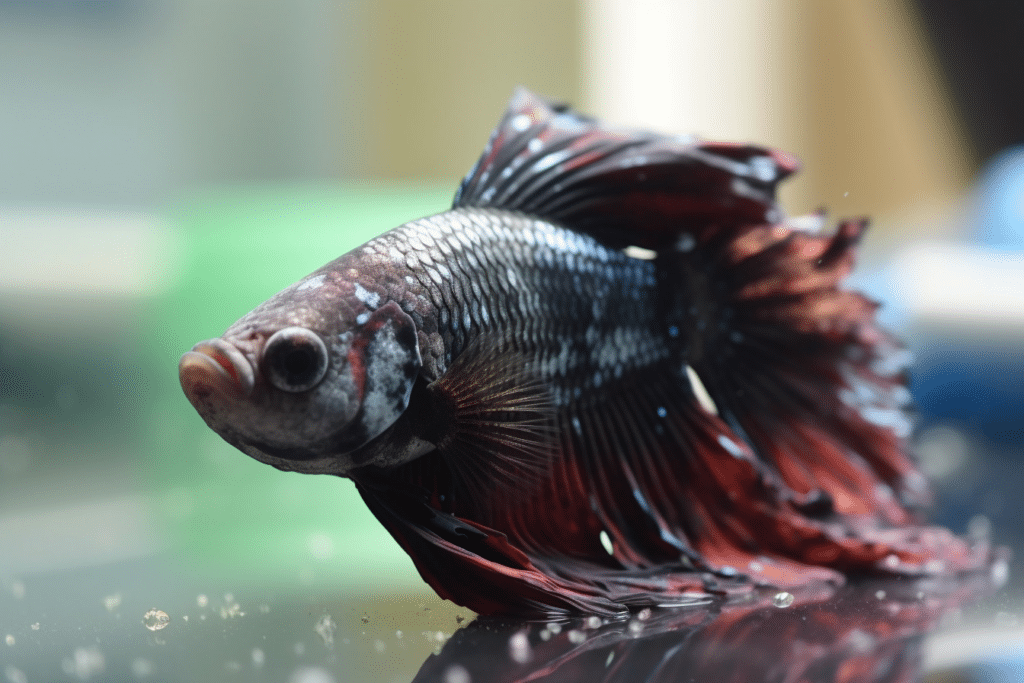
Betta Fin Rot: Symptoms, Causes, Prevention & Treatment
Swim To 🤿 Home Betta Fin Rot: Expert Strategies for Effective Treatment and Prevention While

The Wonderful World of Female Betta Fish!
Swim To 🤿 Home The Wonderful World of Female Betta Fish These colorful and captivating
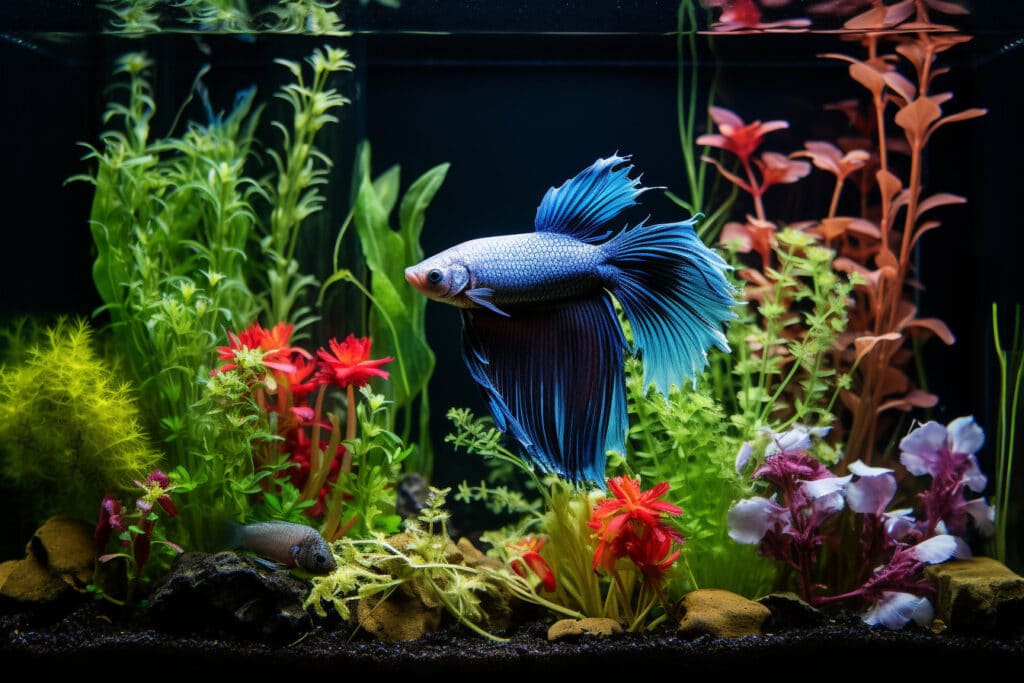
How Long Do Betta Fish Live in Wild and Captivity?
Home How Long Do Betta Fish Live in Wild and Captivity? In this blog post,
